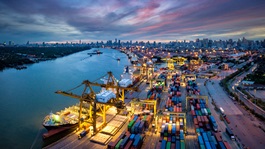
Publication
Navigating international trade and tariffs
Impacts of evolving trade regulations and compliance risks


South Africa’s carbon emissions are disproportionately large on a global scale. This results from a number of factors, but is primarily due to its reliance on coal in energy generation. In an attempt to minimise the impact, the country has made a number of international and national commitments to reduce greenhouse gas (GHG) emissions.
South Africa is a signatory to the 2015 Paris Agreement, which came into force on November 4, 2016. The Paris Agreement requests each country to outline and communicate their post-2020 climate actions, which are known as their Nationally Determined Contributions (NDCs). All Parties to the Agreement are obliged to report regularly on their emissions and on their reduction efforts. South Africa’s NDC was submitted on August 1, 2015 and will be assessed during the global stocktake which is due to take place every five years after implementation, from 2020 onwards.
South Africa’s NDC identifies a carbon tax as one of the measures to be introduced to achieve the absolute decline of GHGs from 2040. Under its national commitment, GHG emissions are expected to peak between 2020 and 2025, plateau between 2025 and 2035 and decline thereafter.
Government statements on the 2018 Carbon Tax Bill indicate that the purpose of the carbon tax is to send the necessary price signals to change consumer behaviour, stimulate investor appetite to shift towards low-carbon options and give effect to the polluter pays principle by incorporating the costs of damage caused by greenhouse gases in the price of high carbon-emitting goods and services.
The South African Carbon Tax Bill is the result of an almost decade-long process, which started with the release of the Carbon Tax Discussion Paper in 2010 and included the Carbon Tax Policy in 2013 and the Carbon Offsets Paper in 2014. This led to the first Draft Bill being published in November 2015.
A consultation with stakeholders and comments received by parliament culminated in the current version of the Bill, which was tabled in parliament by South Africa’s finance minister on November 20, 2018, and passed by the National Assembly on February 19, 2019. Once the bill is passed by the National Council of Provinces, it will be sent to the president to be signed into law.
The 2019 Budget Speech announced that the law will come into effect on June 1 2019.
Once implemented, the law will operate in a two-phase system, with the first phase running from June 1, 2019 to December 31, 2022 and the second phase from 2023 to 2030.
A person will be liable to pay the carbon tax if that person conducts an activity that results in the emission of GHGs above the prescribed emission thresholds. The greenhouse gases covered include carbon dioxide, methane, nitrous oxide, perfluorocarbons, hydrofluorocarbons and sulphur hexafluoride. A ’person’ includes companies, individuals and public entities.
The three general categories of emissions specified are fuel combustion, industrial processes and fugitive emissions. The emission thresholds for these categories are set out in Schedule 2 of the Bill and have been formulated to be sector-specific.
The tax, which is measured per ton of CO2 or CO2 equivalent, has a headline tax rate of R120 per ton of CO2 equivalent. This rate is subject to inflation plus 2% until end of phase 1, and will be increased in line with inflation thereafter. The headline rate is subject to a number of tax breaks in the form of allowances and performance incentives. These offsets provide a baseline tax break of 60% and a maximum tax break of 95% during phase 1. The tax breaks create an effective carbon tax rate of between R6/t and R48/t for carbon dioxide-equivalent (CO2e) emissions during phase 1.
The National Treasury has advised that energy-intensive sectors will be cushioned through measures that have been introduced to ensure that the tax does not increase the price of electricity. This is set to be achieved through tax credits for the renewable-energy premia built into the electricity tariffs, as well as a credit for the existing electricity generation levy.
According to a statement from the Treasury, the South African Revenue Service will publish draft rules for consultation, which will regulate carbon offsets, trade exposure regulations and benchmarking. The performance and operational structure of the tax will be reviewed after three years.
The impacts on industry will vary by sector, while the average consumer will feel the effects of direct and indirect costs as the price of goods and services rise. It has already been confirmed that one effect of the tax will be a fuel increase of 9 c/l on petrol and 10c/l on diesel as of June 1, 2019.
Businesses should assess the extent of their exposure to the tax and act accordingly. As an example, price increases on taxable activities such as transport could necessitate a supply chain review. Additionally, implementation of any mitigation measures to minimise the impact of the tax should be accomplished during phase 1, since the operational specifics of phase 2 are still uncertain.
Finally, and on a positive note, the intention to move away from carbon reliance and the recent structural changes at national public utility Eskom may create an opportunity for investors in the field of renewable energy and assorted green industries.

Publication
Impacts of evolving trade regulations and compliance risks
Publication
The insurance industry is facing a rapidly changing litigation environment. Emerging risks, regulatory developments, and technological advancements are reshaping how insurers approach underwriting, claims, and risk management. Below is an overview of the most significant trends impacting the sector.
Subscribe and stay up to date with the latest legal news, information and events . . .
© Norton Rose Fulbright LLP 2025